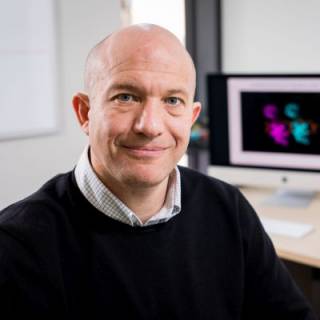Dr Marc Mansour has found that tiny genetic changes can create binding sites for transcription factors, driving the aberrant expression of oncogenes and the development of leukaemia.
The search for cancer-causing mutations has traditionally focused on changes to protein-coding regions of the genome, and the production of dysfunctional proteins. However, cancer can also be driven by the persistent expression of genes at the wrong time or in the wrong place. Commonly, this can occur after a chromosomal rearrangement, juxtaposing an oncogene and an active promoter.
Dr Mansour, a clinical haematologist at UCL, has long been interested in the genetic changes underlying adult leukaemias, such as T-cell acute lymphoblastic leukaemia (T-ALL). Following early work on the role of mutations in the Notch pathway, he focused on the TAL1 gene, activation of which has been implicated in around half of all cases of T-ALL.
In collaboration with Professor Tom Look in Boston, Dr Mansour showed that TAL1 exerts its growth-promoting effects through a microRNA acting on a tumour suppressor gene [1]. Notably, he also discovered that TAL1 could be activated by simple mutations within adjacent non-coding regions, which created novel enhancer elements [2]. The new elements recruit the MYB transcription factor and other proteins that drive expression of the TAL1 gene, in turn leading to leukaemia.
The study was pivotal in demonstrating that small genetic changes in non-coding regions, sometimes as trivial as a single base pair, could be primary drivers of cancer. Dr Mansour and colleagues went on to widen their search, identifying other oncogenes affected by non-coding mutations, such as LMO2, in which small insertions generated a new enhancer element [3]. They also showed that mutations in an intron of LMO2 can create a new promoter to drive overexpression and the development of T-ALL [4].
The nature of the mutations suggests that some have been caused by the misdirected action of the APOBEC DNA-modifying viral defence system [5] or the RAG enzymatic machinery responsible for rearrangement of antigen receptor genes - potentially explaining why small-scale mutations are particularly prevalent in lymphocytes.
Having shown conclusively that small changes in non-coding regions can drive cancer, his group has screened cancer genomes for similar mutations, to identify new oncogenes driving leukaemia. Notably, this search has identified candidate mutations affecting the expression of genes that are potentially targetable by existing therapeutics.
Fishing with fish
Alongside this work, Dr Mansour has begun studies in zebrafish exploiting the concept of 'synthetic lethality'. Cancer can be driven by the loss of genes (tumour suppressors), which cannot be targeted pharmacologically. However, loss of such genes may lead cancer cells to become reliant on other genes, in ways that normal cells are not. These secondary genes are therefore appealing targets for drug discovery.
To identify such genes, Dr Mansour has engineered fish so they lack a gene commonly lost in aggressive T-cell leukaemias, ezh2, and screened fish embryos for sensitivity to a range of existing drugs. This work revealed that leukaemic cells lacking ezh2 (but not normal cells) were particularly sensitive to certain drugs that are already available for other conditions. A parallel project in human cells has discovered that CHK1 kinase inhibitors, drugs already used to treat solid tumours, are particularly effective in cells engineered to lack the EZH2 gene, highlighting CHK1 inhibitors as possible therapies for this class of T-cell leukaemias [6].
The work has relied on the extensive zebrafish facility at UCL run by Professor Steve Wilson. Dr Mansour's work also benefits from UCL's role as the national trial centre for the UKALL14 trial, run by Professor Adele Fielding, which provides ready access to patient samples, as well as his own patients - who, as well as providing samples, could in the future be enrolled in trials of new therapies.
- Mansour MR et al. The TAL1 complex targets the FBXW7 tumor suppressor by activating miR-223 in human T cell acute lymphoblastic leukemia. J Exp Med. 2013;210(8):1545-57.
- Mansour MR et al. Oncogene regulation. An oncogenic super-enhancer formed through somatic mutation of a noncoding intergenic element. Science. 2014;346(6215):1373-7.
- Abraham BJ et al. Small genomic insertions form enhancers that misregulate oncogenes. Nat Commun. 2017;8:14385.
- Rahman S et al. Activation of the LMO2 oncogene through a somatically acquired neomorphic promoter in T-cell acute lymphoblastic leukemia. Blood. 2017;129(24):3221-3226.
- Li Z et al. APOBEC signature mutation generates an oncogenic enhancer that drives LMO1 expression in T-ALL. Leukemia. 2017;31(10):2057-2064.
- Leon TE et al. Synthetic lethal screening identifies CHK1 inhibition as an exploitable vulnerability in EZH2 deficient T-ALL. Blood. 2017;130:1325.
 Close
Close


